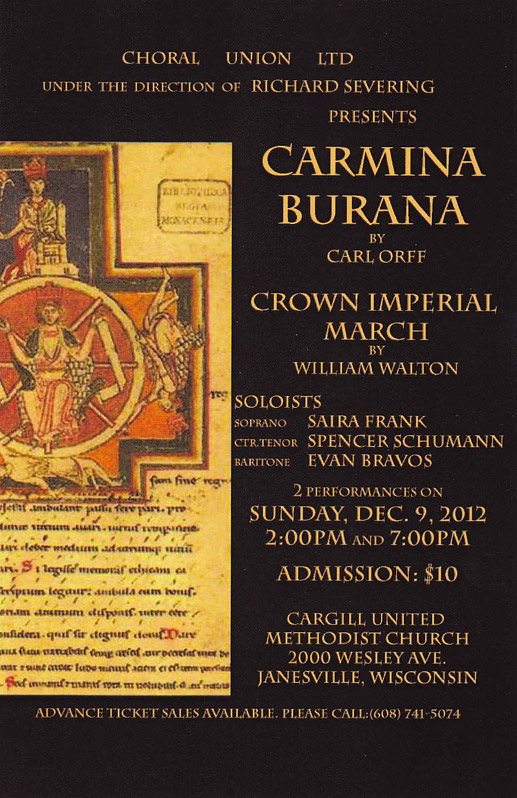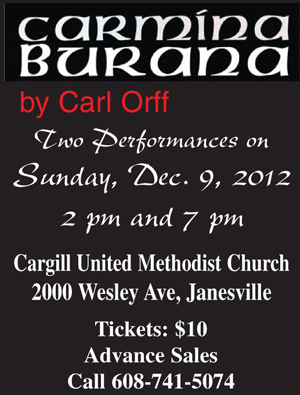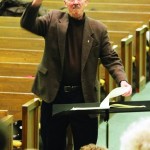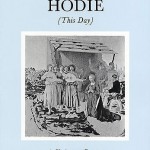Live Videos of the 2012 Choral Union Presentation of “Carmina Burana” by Carl Orff

Carmina Burana is a scenic cantata composed by Carl Orff in 1935 and 1936. It is based on 24 of the poems found in the medieval collection Carmina Burana. Its full Latin title is Carmina Burana: Cantiones profanæ cantoribus et choris cantandæ comitantibus instrumentis atque imaginibus magicis (“Songs of Beuern: Secular songs for singers and choruses to be sung together with instruments and magic images.”) Carmina Burana is part of Trionfi, the musical triptych that also includes the cantata Catulli Carmina and Trionfo di Afrodite. The first and last movements are called “Fortuna Imperatrix Mundi” and start with the very well known “O Fortuna“.
Carmina Burana is a powerful piece of 20th century music that often introduces young (and not so young!) people to the world of “serious” or “classical” music.
– Learn More about Carmina Burana Here
Conductor:
Richard Severing – learn more
“Carmina Burana” by Carl Orff
Featured Soloists:
Soprano Saira Frank – learn more
Counter-tenor Spencer Schumann – learn more
Baritone Evans Bravos – learn more
Orchestra Piece
“Crown Imperial March” by William Walton
Location of Performance:
Cargill United Methodist Church, 2000 Welsey Ave, Janesville, WI
– Get Driving Directions
More About Carl Orff

Born: July 10th, 1895
Died: March 29th, 1982
Country of origin: Germany
Orff’s music, his musikē – I deliberately utilise the Greek expression – offers less for the ear than traditional opera music. In exchange, it involves all the senses; it is not just sound, but also dance; not just tone but also playing; not only singing but also scenes and theatre – it is music in the sense of an artistic muse uniting and fusing all the arts , as originally conceived by the Ancient Greeks. (Hans Maier)
Carl Orff was born on 10 July 1895 in Munich. He received his first piano tuition at the early age of five, and subsequently also cello and organ lessons. Evidence shows that he regularly attended the theatre and opera from 1903 onwards. In 1911, his first work was published: the lied “Eiland, ein Sang vom Chiemsee”, although Orff up to this point had not yet begun systematic courses in music theory. From 1912 to 1914, he studied composition with Anton Beer-Walbrunn at the Munich Akademie der Tonkunst and from 1915 piano with Hermann Zilcher. In 1915, Orff was able to gather initial practical experience in the theatre, worked as repetiteur and one year later was appointed as kapellmeister of the Munich Chamber Theatre. Following a brief period of military service, he was appointed as kapellmeister assisting Wilhelm Furtwängler at the National Theatre in Mannheim and the Landestheater Darmstadt. He received further training in composition from Heinrich Kaminski and undertook an extensive study of Bach, Buxtehude, Pachelbel and particularly Monteverdi. A co-founder of the “Günther School” for gymnastics, music and dance in Munich (1924), Orff became the director of the department for dance and musical education. This was for Orff an ideal experimental educational field for the development of the “Orff Schulwerk” (1930-1934/1950-1954) which was distributed with great success worldwide and continues today to be utilised within the areas of social and therapeutic education. In 1936, Orff received the commission to compose a part of the processional music for the opening ceremony of the Olympic Games. From 1950 to 1960, he held master classes for composition at the Staatliche Hochschule für Musik in Munich. From 1955, he was resident in Dießen on Lake Ammer and died on 29 March 1982 in Munich.
Further information About Carl Orff:




Leave a Reply
Want to join the discussion?Feel free to contribute!